Corporate Communication Strategies: SSBH MBA Assignment Report
VerifiedAdded on 2022/01/15
|17
|8218
|119
Report
AI Summary
This report, presented by Ahmed Hisham Sanad and supervised by Dr. Tamer Karam, examines corporate communication strategies, their purpose, and their link to corporate objectives. The report delves into the importance of corporate communications to a named organization, likely Google, using a case study focused on Google's strategies in China. It explores both internal and external corporate communication audits, detailing their processes and significance. Furthermore, the report analyzes the strategic objectives of corporate communications and their impact on various audiences. It also develops measures to assess the effectiveness of current organizational corporate communications, culminating in conclusions and references to support the findings. The report emphasizes the role of corporate communications in building and preserving a company's reputation and interacting with stakeholders.
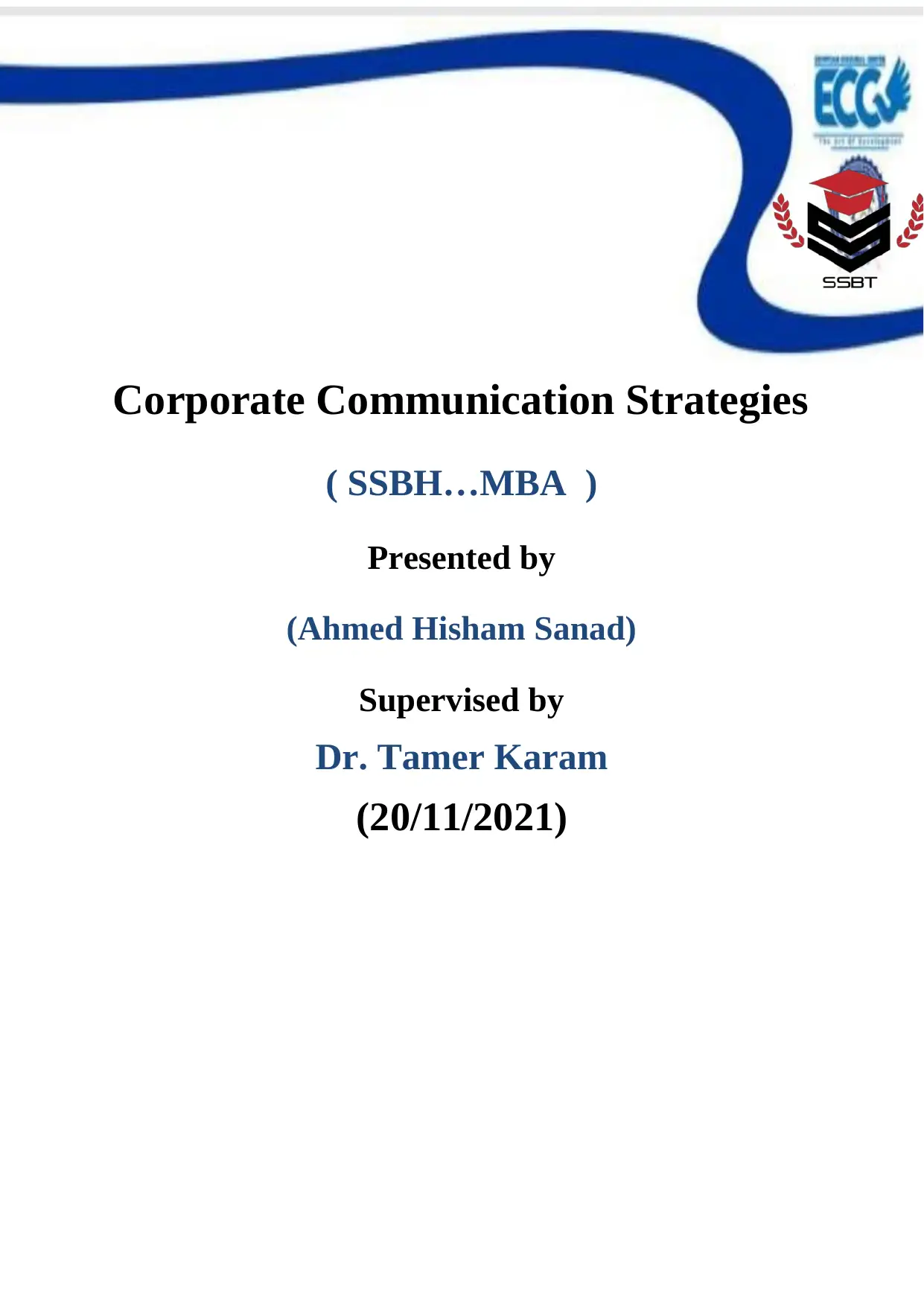
1
Corporate Communication Strategies
( SSBH…MBA )
Presented by
(Ahmed Hisham Sanad)
Supervised by
Dr. Tamer Karam
(20/11/2021)
Corporate Communication Strategies
( SSBH…MBA )
Presented by
(Ahmed Hisham Sanad)
Supervised by
Dr. Tamer Karam
(20/11/2021)
Paraphrase This Document
Need a fresh take? Get an instant paraphrase of this document with our AI Paraphraser
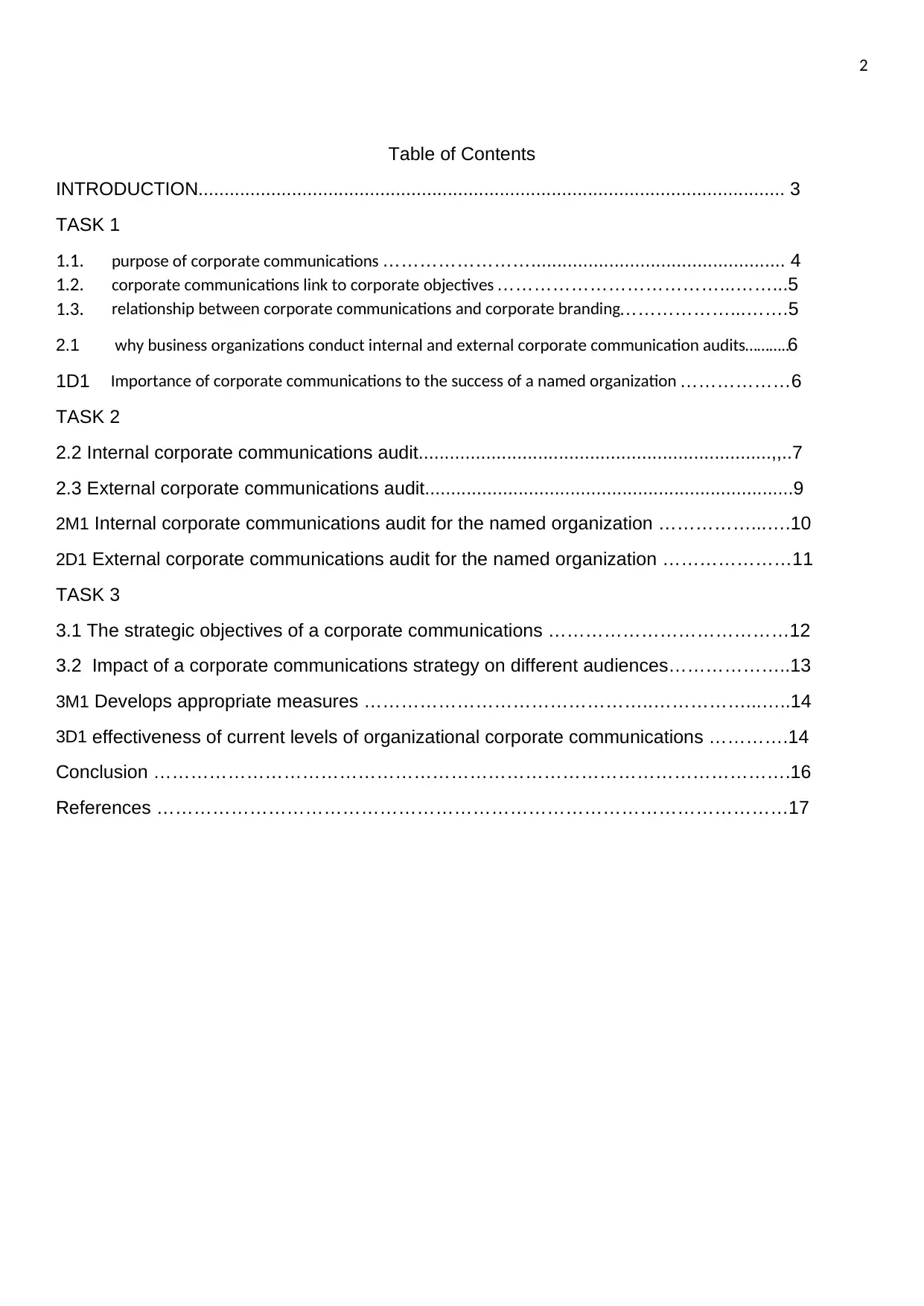
2
Table of Contents
INTRODUCTION................................................................................................................. 3
TASK 1
1.1. purpose of corporate communications ……………………................................................. 4
1.2. corporate communications link to corporate objectives ………………………………...……...5
1.3. relationship between corporate communications and corporate branding………………...…….5
2.1 why business organizations conduct internal and external corporate communication audits………..6
1D1 Importance of corporate communications to the success of a named organization ………………6
TASK 2
2.2 Internal corporate communications audit....................................................................,,..7
2.3 External corporate communications audit.......................................................................9
2M1 Internal corporate communications audit for the named organization ……………...….10
2D1 External corporate communications audit for the named organization …………………11
TASK 3
3.1 The strategic objectives of a corporate communications …………………………………12
3.2 Impact of a corporate communications strategy on different audiences………………..13
3M1 Develops appropriate measures ………………………………………..……………...…..14
3D1 effectiveness of current levels of organizational corporate communications ………….14
Conclusion ………………………………………………………………………………………….16
References …………………………………………………………………………………………17
Table of Contents
INTRODUCTION................................................................................................................. 3
TASK 1
1.1. purpose of corporate communications ……………………................................................. 4
1.2. corporate communications link to corporate objectives ………………………………...……...5
1.3. relationship between corporate communications and corporate branding………………...…….5
2.1 why business organizations conduct internal and external corporate communication audits………..6
1D1 Importance of corporate communications to the success of a named organization ………………6
TASK 2
2.2 Internal corporate communications audit....................................................................,,..7
2.3 External corporate communications audit.......................................................................9
2M1 Internal corporate communications audit for the named organization ……………...….10
2D1 External corporate communications audit for the named organization …………………11
TASK 3
3.1 The strategic objectives of a corporate communications …………………………………12
3.2 Impact of a corporate communications strategy on different audiences………………..13
3M1 Develops appropriate measures ………………………………………..……………...…..14
3D1 effectiveness of current levels of organizational corporate communications ………….14
Conclusion ………………………………………………………………………………………….16
References …………………………………………………………………………………………17
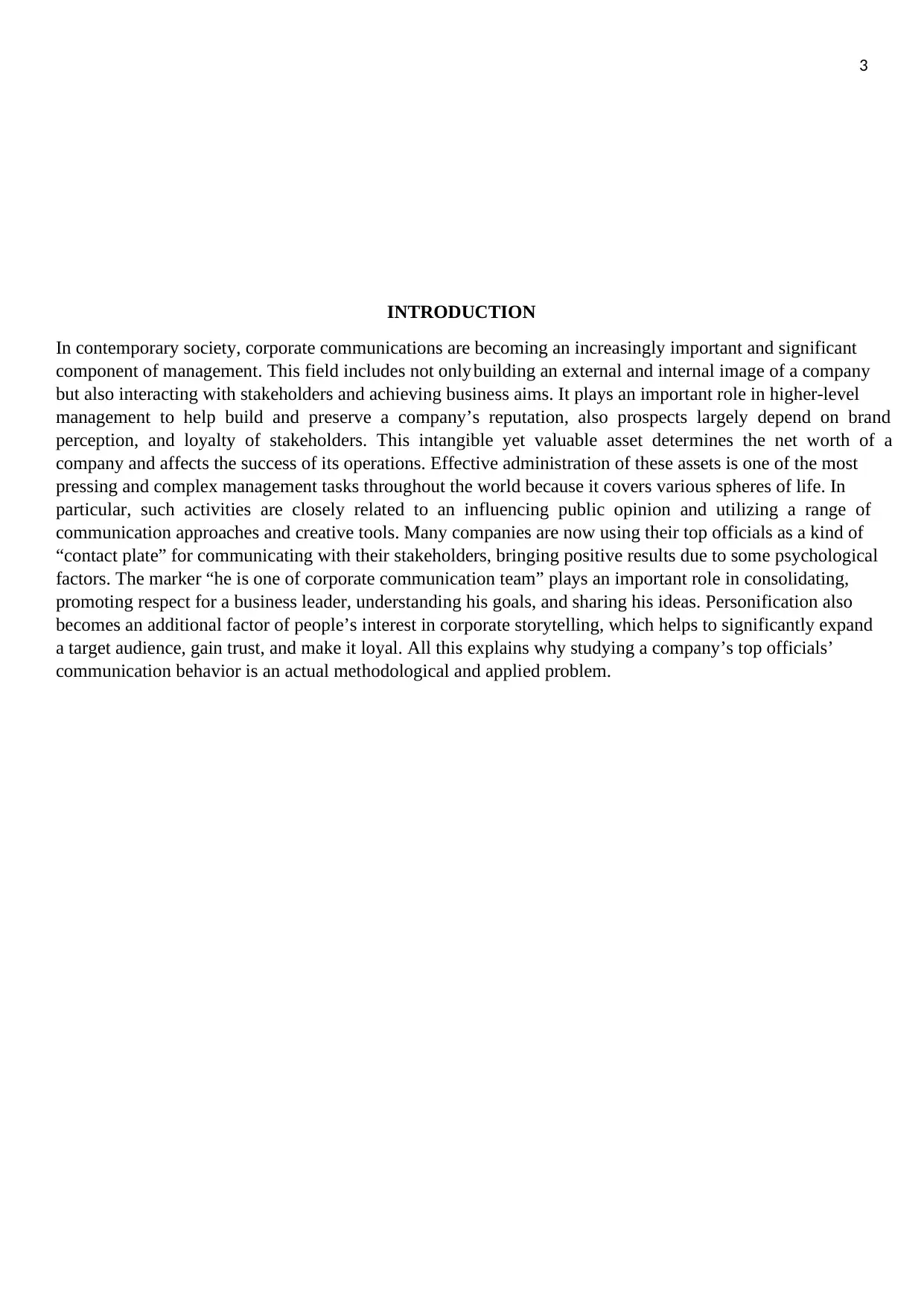
3
INTRODUCTION
In contemporary society, corporate communications are becoming an increasingly important and significant
component of management. This field includes not onlybuilding an external and internal image of a company
but also interacting with stakeholders and achieving business aims. It plays an important role in higher-level
management to help build and preserve a company’s reputation, also prospects largely depend on brand
perception, and loyalty of stakeholders. This intangible yet valuable asset determines the net worth of a
company and affects the success of its operations. Effective administration of these assets is one of the most
pressing and complex management tasks throughout the world because it covers various spheres of life. In
particular, such activities are closely related to an influencing public opinion and utilizing a range of
communication approaches and creative tools. Many companies are now using their top officials as a kind of
“contact plate” for communicating with their stakeholders, bringing positive results due to some psychological
factors. The marker “he is one of corporate communication team” plays an important role in consolidating,
promoting respect for a business leader, understanding his goals, and sharing his ideas. Personification also
becomes an additional factor of people’s interest in corporate storytelling, which helps to significantly expand
a target audience, gain trust, and make it loyal. All this explains why studying a company’s top officials’
communication behavior is an actual methodological and applied problem.
INTRODUCTION
In contemporary society, corporate communications are becoming an increasingly important and significant
component of management. This field includes not onlybuilding an external and internal image of a company
but also interacting with stakeholders and achieving business aims. It plays an important role in higher-level
management to help build and preserve a company’s reputation, also prospects largely depend on brand
perception, and loyalty of stakeholders. This intangible yet valuable asset determines the net worth of a
company and affects the success of its operations. Effective administration of these assets is one of the most
pressing and complex management tasks throughout the world because it covers various spheres of life. In
particular, such activities are closely related to an influencing public opinion and utilizing a range of
communication approaches and creative tools. Many companies are now using their top officials as a kind of
“contact plate” for communicating with their stakeholders, bringing positive results due to some psychological
factors. The marker “he is one of corporate communication team” plays an important role in consolidating,
promoting respect for a business leader, understanding his goals, and sharing his ideas. Personification also
becomes an additional factor of people’s interest in corporate storytelling, which helps to significantly expand
a target audience, gain trust, and make it loyal. All this explains why studying a company’s top officials’
communication behavior is an actual methodological and applied problem.
⊘ This is a preview!⊘
Do you want full access?
Subscribe today to unlock all pages.

Trusted by 1+ million students worldwide
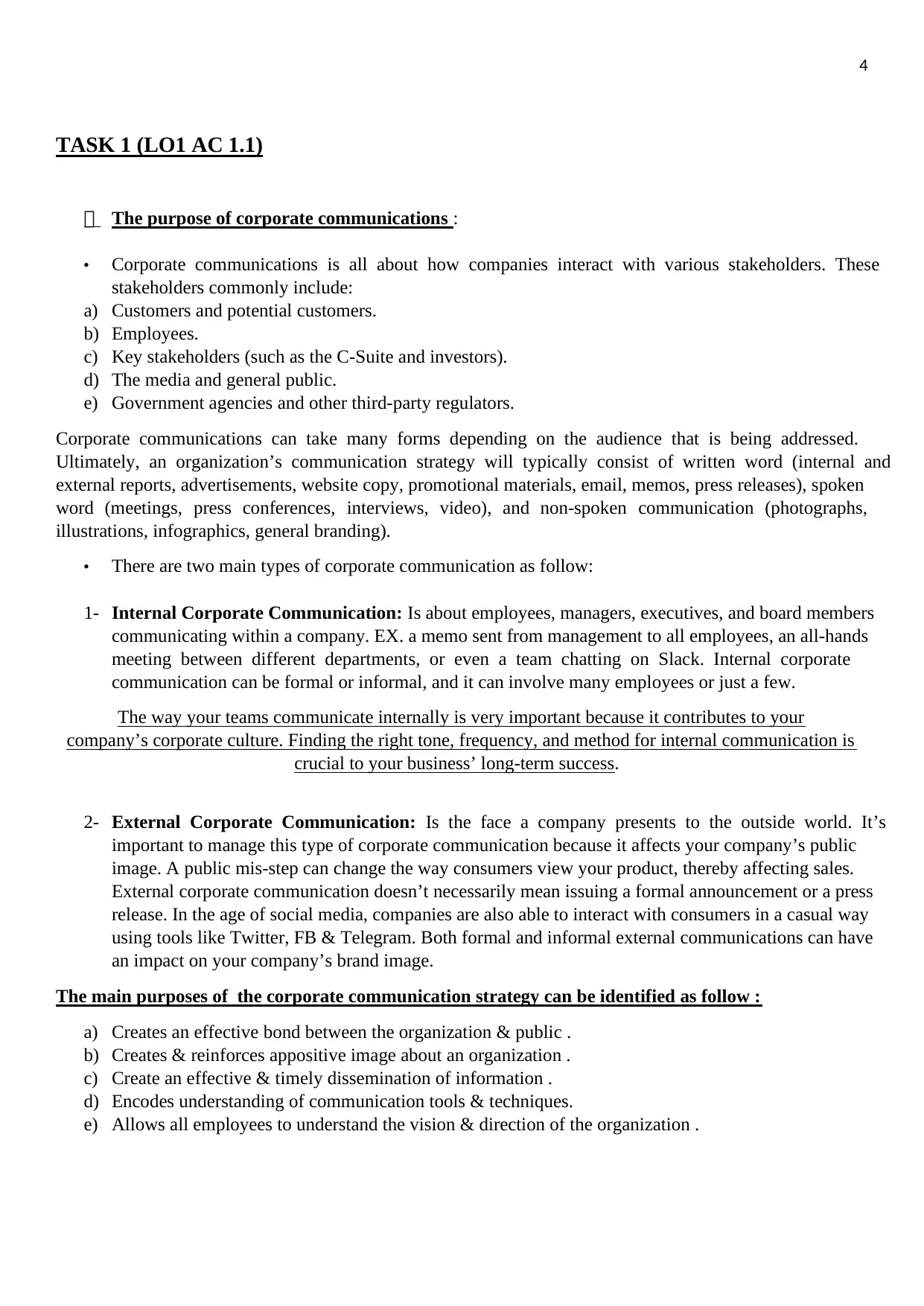
4
TASK 1 (LO1 AC 1.1)
The purpose of corporate communications :
• Corporate communications is all about how companies interact with various stakeholders. These
stakeholders commonly include:
a) Customers and potential customers.
b) Employees.
c) Key stakeholders (such as the C-Suite and investors).
d) The media and general public.
e) Government agencies and other third-party regulators.
Corporate communications can take many forms depending on the audience that is being addressed.
Ultimately, an organization’s communication strategy will typically consist of written word (internal and
external reports, advertisements, website copy, promotional materials, email, memos, press releases), spoken
word (meetings, press conferences, interviews, video), and non-spoken communication (photographs,
illustrations, infographics, general branding).
• There are two main types of corporate communication as follow:
1- Internal Corporate Communication: Is about employees, managers, executives, and board members
communicating within a company. EX. a memo sent from management to all employees, an all-hands
meeting between different departments, or even a team chatting on Slack. Internal corporate
communication can be formal or informal, and it can involve many employees or just a few.
The way your teams communicate internally is very important because it contributes to your
company’s corporate culture. Finding the right tone, frequency, and method for internal communication is
crucial to your business’ long-term success.
2- External Corporate Communication: Is the face a company presents to the outside world. It’s
important to manage this type of corporate communication because it affects your company’s public
image. A public mis-step can change the way consumers view your product, thereby affecting sales.
External corporate communication doesn’t necessarily mean issuing a formal announcement or a press
release. In the age of social media, companies are also able to interact with consumers in a casual way
using tools like Twitter, FB & Telegram. Both formal and informal external communications can have
an impact on your company’s brand image.
The main purposes of the corporate communication strategy can be identified as follow :
a) Creates an effective bond between the organization & public .
b) Creates & reinforces appositive image about an organization .
c) Create an effective & timely dissemination of information .
d) Encodes understanding of communication tools & techniques.
e) Allows all employees to understand the vision & direction of the organization .
TASK 1 (LO1 AC 1.1)
The purpose of corporate communications :
• Corporate communications is all about how companies interact with various stakeholders. These
stakeholders commonly include:
a) Customers and potential customers.
b) Employees.
c) Key stakeholders (such as the C-Suite and investors).
d) The media and general public.
e) Government agencies and other third-party regulators.
Corporate communications can take many forms depending on the audience that is being addressed.
Ultimately, an organization’s communication strategy will typically consist of written word (internal and
external reports, advertisements, website copy, promotional materials, email, memos, press releases), spoken
word (meetings, press conferences, interviews, video), and non-spoken communication (photographs,
illustrations, infographics, general branding).
• There are two main types of corporate communication as follow:
1- Internal Corporate Communication: Is about employees, managers, executives, and board members
communicating within a company. EX. a memo sent from management to all employees, an all-hands
meeting between different departments, or even a team chatting on Slack. Internal corporate
communication can be formal or informal, and it can involve many employees or just a few.
The way your teams communicate internally is very important because it contributes to your
company’s corporate culture. Finding the right tone, frequency, and method for internal communication is
crucial to your business’ long-term success.
2- External Corporate Communication: Is the face a company presents to the outside world. It’s
important to manage this type of corporate communication because it affects your company’s public
image. A public mis-step can change the way consumers view your product, thereby affecting sales.
External corporate communication doesn’t necessarily mean issuing a formal announcement or a press
release. In the age of social media, companies are also able to interact with consumers in a casual way
using tools like Twitter, FB & Telegram. Both formal and informal external communications can have
an impact on your company’s brand image.
The main purposes of the corporate communication strategy can be identified as follow :
a) Creates an effective bond between the organization & public .
b) Creates & reinforces appositive image about an organization .
c) Create an effective & timely dissemination of information .
d) Encodes understanding of communication tools & techniques.
e) Allows all employees to understand the vision & direction of the organization .
Paraphrase This Document
Need a fresh take? Get an instant paraphrase of this document with our AI Paraphraser
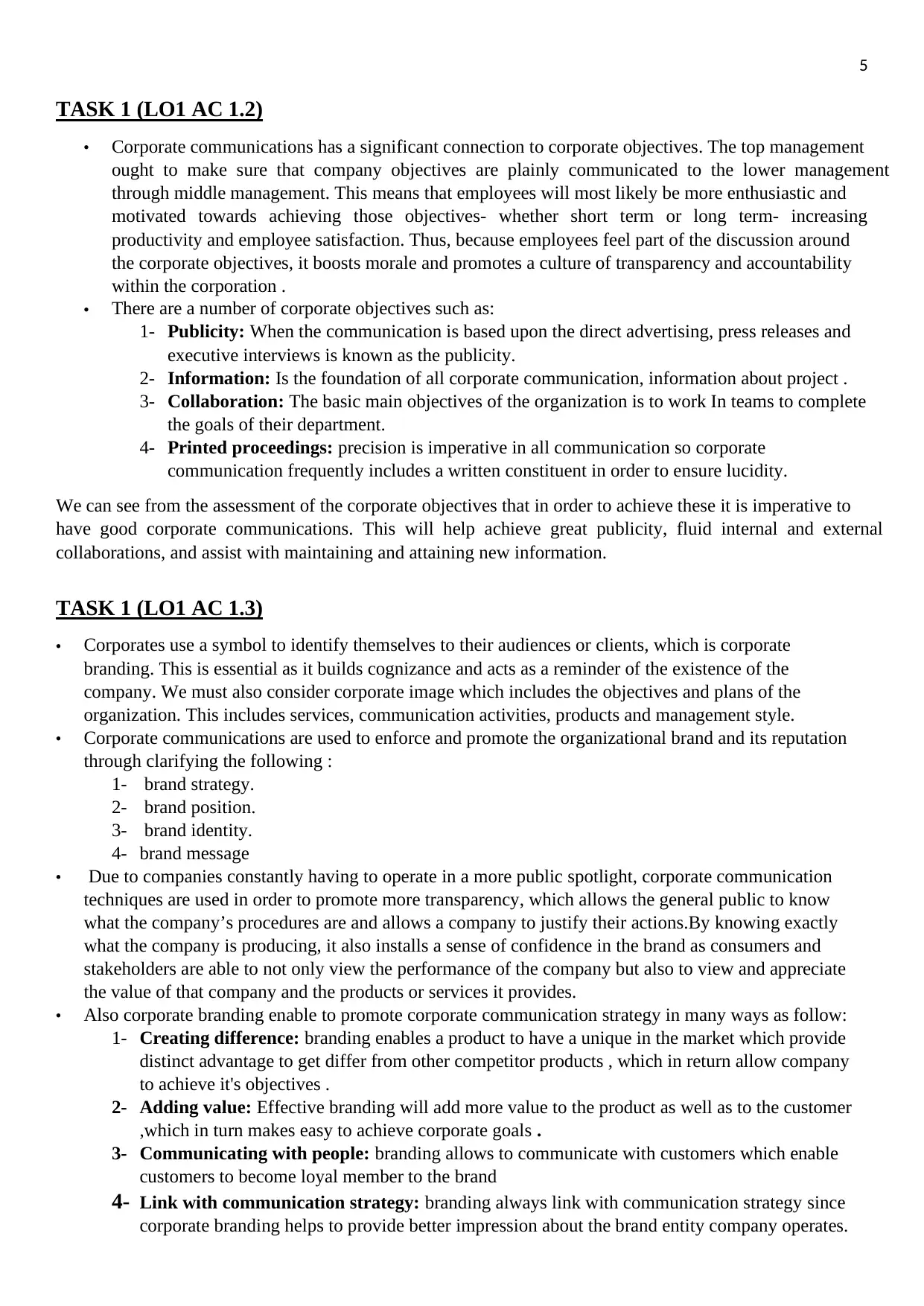
5
TASK 1 (LO1 AC 1.2)
• Corporate communications has a significant connection to corporate objectives. The top management
ought to make sure that company objectives are plainly communicated to the lower management
through middle management. This means that employees will most likely be more enthusiastic and
motivated towards achieving those objectives- whether short term or long term- increasing
productivity and employee satisfaction. Thus, because employees feel part of the discussion around
the corporate objectives, it boosts morale and promotes a culture of transparency and accountability
within the corporation .
• There are a number of corporate objectives such as:
1- Publicity: When the communication is based upon the direct advertising, press releases and
executive interviews is known as the publicity.
2- Information: Is the foundation of all corporate communication, information about project .
3- Collaboration: The basic main objectives of the organization is to work In teams to complete
the goals of their department.
4- Printed proceedings: precision is imperative in all communication so corporate
communication frequently includes a written constituent in order to ensure lucidity.
We can see from the assessment of the corporate objectives that in order to achieve these it is imperative to
have good corporate communications. This will help achieve great publicity, fluid internal and external
collaborations, and assist with maintaining and attaining new information.
TASK 1 (LO1 AC 1.3)
• Corporates use a symbol to identify themselves to their audiences or clients, which is corporate
branding. This is essential as it builds cognizance and acts as a reminder of the existence of the
company. We must also consider corporate image which includes the objectives and plans of the
organization. This includes services, communication activities, products and management style.
• Corporate communications are used to enforce and promote the organizational brand and its reputation
through clarifying the following :
1- brand strategy.
2- brand position.
3- brand identity.
4- brand message
• Due to companies constantly having to operate in a more public spotlight, corporate communication
techniques are used in order to promote more transparency, which allows the general public to know
what the company’s procedures are and allows a company to justify their actions.By knowing exactly
what the company is producing, it also installs a sense of confidence in the brand as consumers and
stakeholders are able to not only view the performance of the company but also to view and appreciate
the value of that company and the products or services it provides.
• Also corporate branding enable to promote corporate communication strategy in many ways as follow:
1- Creating difference: branding enables a product to have a unique in the market which provide
distinct advantage to get differ from other competitor products , which in return allow company
to achieve it's objectives .
2- Adding value: Effective branding will add more value to the product as well as to the customer
,which in turn makes easy to achieve corporate goals .
3- Communicating with people: branding allows to communicate with customers which enable
customers to become loyal member to the brand
4- Link with communication strategy: branding always link with communication strategy since
corporate branding helps to provide better impression about the brand entity company operates.
TASK 1 (LO1 AC 1.2)
• Corporate communications has a significant connection to corporate objectives. The top management
ought to make sure that company objectives are plainly communicated to the lower management
through middle management. This means that employees will most likely be more enthusiastic and
motivated towards achieving those objectives- whether short term or long term- increasing
productivity and employee satisfaction. Thus, because employees feel part of the discussion around
the corporate objectives, it boosts morale and promotes a culture of transparency and accountability
within the corporation .
• There are a number of corporate objectives such as:
1- Publicity: When the communication is based upon the direct advertising, press releases and
executive interviews is known as the publicity.
2- Information: Is the foundation of all corporate communication, information about project .
3- Collaboration: The basic main objectives of the organization is to work In teams to complete
the goals of their department.
4- Printed proceedings: precision is imperative in all communication so corporate
communication frequently includes a written constituent in order to ensure lucidity.
We can see from the assessment of the corporate objectives that in order to achieve these it is imperative to
have good corporate communications. This will help achieve great publicity, fluid internal and external
collaborations, and assist with maintaining and attaining new information.
TASK 1 (LO1 AC 1.3)
• Corporates use a symbol to identify themselves to their audiences or clients, which is corporate
branding. This is essential as it builds cognizance and acts as a reminder of the existence of the
company. We must also consider corporate image which includes the objectives and plans of the
organization. This includes services, communication activities, products and management style.
• Corporate communications are used to enforce and promote the organizational brand and its reputation
through clarifying the following :
1- brand strategy.
2- brand position.
3- brand identity.
4- brand message
• Due to companies constantly having to operate in a more public spotlight, corporate communication
techniques are used in order to promote more transparency, which allows the general public to know
what the company’s procedures are and allows a company to justify their actions.By knowing exactly
what the company is producing, it also installs a sense of confidence in the brand as consumers and
stakeholders are able to not only view the performance of the company but also to view and appreciate
the value of that company and the products or services it provides.
• Also corporate branding enable to promote corporate communication strategy in many ways as follow:
1- Creating difference: branding enables a product to have a unique in the market which provide
distinct advantage to get differ from other competitor products , which in return allow company
to achieve it's objectives .
2- Adding value: Effective branding will add more value to the product as well as to the customer
,which in turn makes easy to achieve corporate goals .
3- Communicating with people: branding allows to communicate with customers which enable
customers to become loyal member to the brand
4- Link with communication strategy: branding always link with communication strategy since
corporate branding helps to provide better impression about the brand entity company operates.
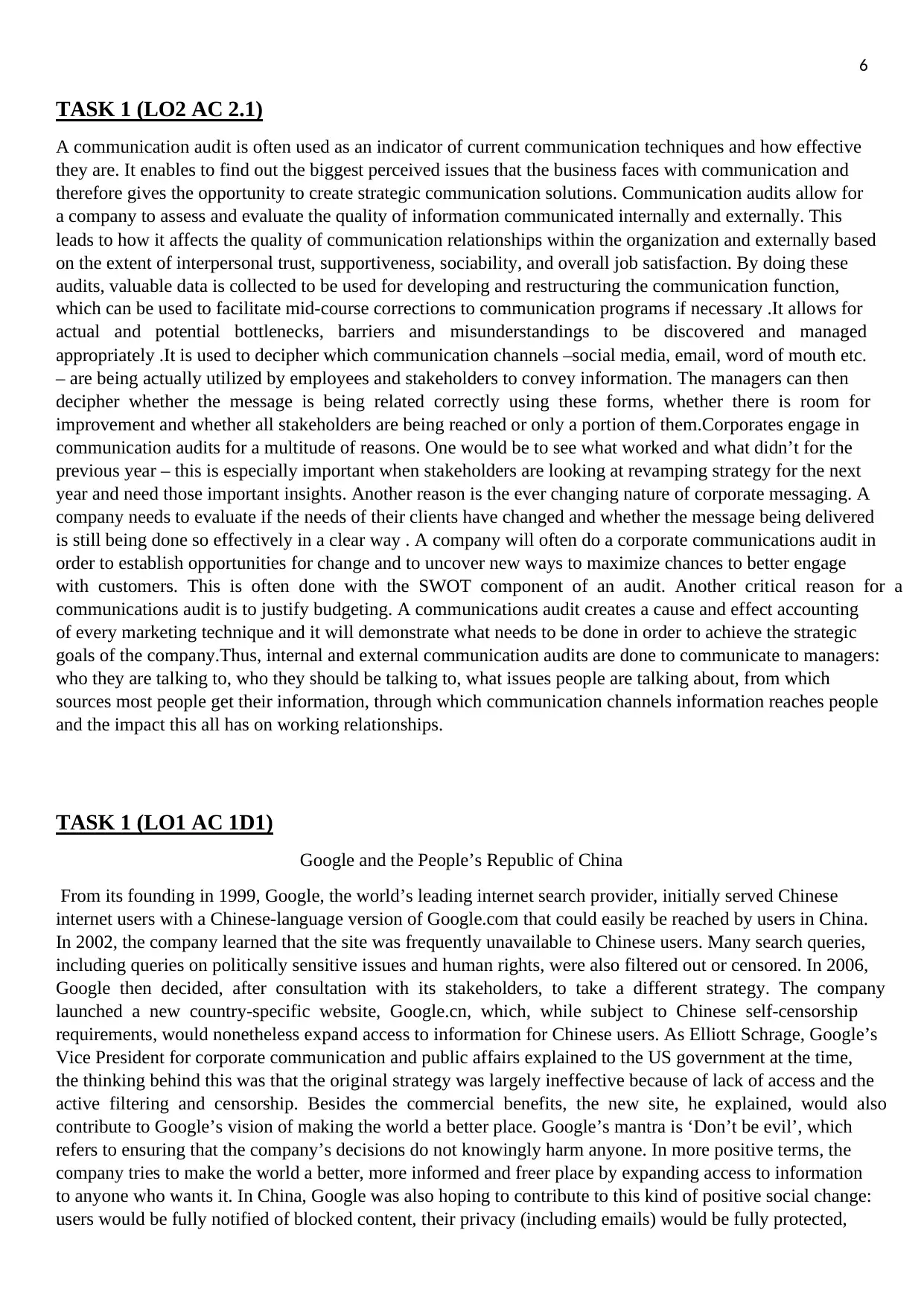
6
TASK 1 (LO2 AC 2.1)
A communication audit is often used as an indicator of current communication techniques and how effective
they are. It enables to find out the biggest perceived issues that the business faces with communication and
therefore gives the opportunity to create strategic communication solutions. Communication audits allow for
a company to assess and evaluate the quality of information communicated internally and externally. This
leads to how it affects the quality of communication relationships within the organization and externally based
on the extent of interpersonal trust, supportiveness, sociability, and overall job satisfaction. By doing these
audits, valuable data is collected to be used for developing and restructuring the communication function,
which can be used to facilitate mid-course corrections to communication programs if necessary .It allows for
actual and potential bottlenecks, barriers and misunderstandings to be discovered and managed
appropriately .It is used to decipher which communication channels –social media, email, word of mouth etc.
– are being actually utilized by employees and stakeholders to convey information. The managers can then
decipher whether the message is being related correctly using these forms, whether there is room for
improvement and whether all stakeholders are being reached or only a portion of them.Corporates engage in
communication audits for a multitude of reasons. One would be to see what worked and what didn’t for the
previous year – this is especially important when stakeholders are looking at revamping strategy for the next
year and need those important insights. Another reason is the ever changing nature of corporate messaging. A
company needs to evaluate if the needs of their clients have changed and whether the message being delivered
is still being done so effectively in a clear way . A company will often do a corporate communications audit in
order to establish opportunities for change and to uncover new ways to maximize chances to better engage
with customers. This is often done with the SWOT component of an audit. Another critical reason for a
communications audit is to justify budgeting. A communications audit creates a cause and effect accounting
of every marketing technique and it will demonstrate what needs to be done in order to achieve the strategic
goals of the company.Thus, internal and external communication audits are done to communicate to managers:
who they are talking to, who they should be talking to, what issues people are talking about, from which
sources most people get their information, through which communication channels information reaches people
and the impact this all has on working relationships.
TASK 1 (LO1 AC 1D1)
Google and the People’s Republic of China
From its founding in 1999, Google, the world’s leading internet search provider, initially served Chinese
internet users with a Chinese-language version of Google.com that could easily be reached by users in China.
In 2002, the company learned that the site was frequently unavailable to Chinese users. Many search queries,
including queries on politically sensitive issues and human rights, were also filtered out or censored. In 2006,
Google then decided, after consultation with its stakeholders, to take a different strategy. The company
launched a new country-specific website, Google.cn, which, while subject to Chinese self-censorship
requirements, would nonetheless expand access to information for Chinese users. As Elliott Schrage, Google’s
Vice President for corporate communication and public affairs explained to the US government at the time,
the thinking behind this was that the original strategy was largely ineffective because of lack of access and the
active filtering and censorship. Besides the commercial benefits, the new site, he explained, would also
contribute to Google’s vision of making the world a better place. Google’s mantra is ‘Don’t be evil’, which
refers to ensuring that the company’s decisions do not knowingly harm anyone. In more positive terms, the
company tries to make the world a better, more informed and freer place by expanding access to information
to anyone who wants it. In China, Google was also hoping to contribute to this kind of positive social change:
users would be fully notified of blocked content, their privacy (including emails) would be fully protected,
TASK 1 (LO2 AC 2.1)
A communication audit is often used as an indicator of current communication techniques and how effective
they are. It enables to find out the biggest perceived issues that the business faces with communication and
therefore gives the opportunity to create strategic communication solutions. Communication audits allow for
a company to assess and evaluate the quality of information communicated internally and externally. This
leads to how it affects the quality of communication relationships within the organization and externally based
on the extent of interpersonal trust, supportiveness, sociability, and overall job satisfaction. By doing these
audits, valuable data is collected to be used for developing and restructuring the communication function,
which can be used to facilitate mid-course corrections to communication programs if necessary .It allows for
actual and potential bottlenecks, barriers and misunderstandings to be discovered and managed
appropriately .It is used to decipher which communication channels –social media, email, word of mouth etc.
– are being actually utilized by employees and stakeholders to convey information. The managers can then
decipher whether the message is being related correctly using these forms, whether there is room for
improvement and whether all stakeholders are being reached or only a portion of them.Corporates engage in
communication audits for a multitude of reasons. One would be to see what worked and what didn’t for the
previous year – this is especially important when stakeholders are looking at revamping strategy for the next
year and need those important insights. Another reason is the ever changing nature of corporate messaging. A
company needs to evaluate if the needs of their clients have changed and whether the message being delivered
is still being done so effectively in a clear way . A company will often do a corporate communications audit in
order to establish opportunities for change and to uncover new ways to maximize chances to better engage
with customers. This is often done with the SWOT component of an audit. Another critical reason for a
communications audit is to justify budgeting. A communications audit creates a cause and effect accounting
of every marketing technique and it will demonstrate what needs to be done in order to achieve the strategic
goals of the company.Thus, internal and external communication audits are done to communicate to managers:
who they are talking to, who they should be talking to, what issues people are talking about, from which
sources most people get their information, through which communication channels information reaches people
and the impact this all has on working relationships.
TASK 1 (LO1 AC 1D1)
Google and the People’s Republic of China
From its founding in 1999, Google, the world’s leading internet search provider, initially served Chinese
internet users with a Chinese-language version of Google.com that could easily be reached by users in China.
In 2002, the company learned that the site was frequently unavailable to Chinese users. Many search queries,
including queries on politically sensitive issues and human rights, were also filtered out or censored. In 2006,
Google then decided, after consultation with its stakeholders, to take a different strategy. The company
launched a new country-specific website, Google.cn, which, while subject to Chinese self-censorship
requirements, would nonetheless expand access to information for Chinese users. As Elliott Schrage, Google’s
Vice President for corporate communication and public affairs explained to the US government at the time,
the thinking behind this was that the original strategy was largely ineffective because of lack of access and the
active filtering and censorship. Besides the commercial benefits, the new site, he explained, would also
contribute to Google’s vision of making the world a better place. Google’s mantra is ‘Don’t be evil’, which
refers to ensuring that the company’s decisions do not knowingly harm anyone. In more positive terms, the
company tries to make the world a better, more informed and freer place by expanding access to information
to anyone who wants it. In China, Google was also hoping to contribute to this kind of positive social change:
users would be fully notified of blocked content, their privacy (including emails) would be fully protected,
⊘ This is a preview!⊘
Do you want full access?
Subscribe today to unlock all pages.

Trusted by 1+ million students worldwide
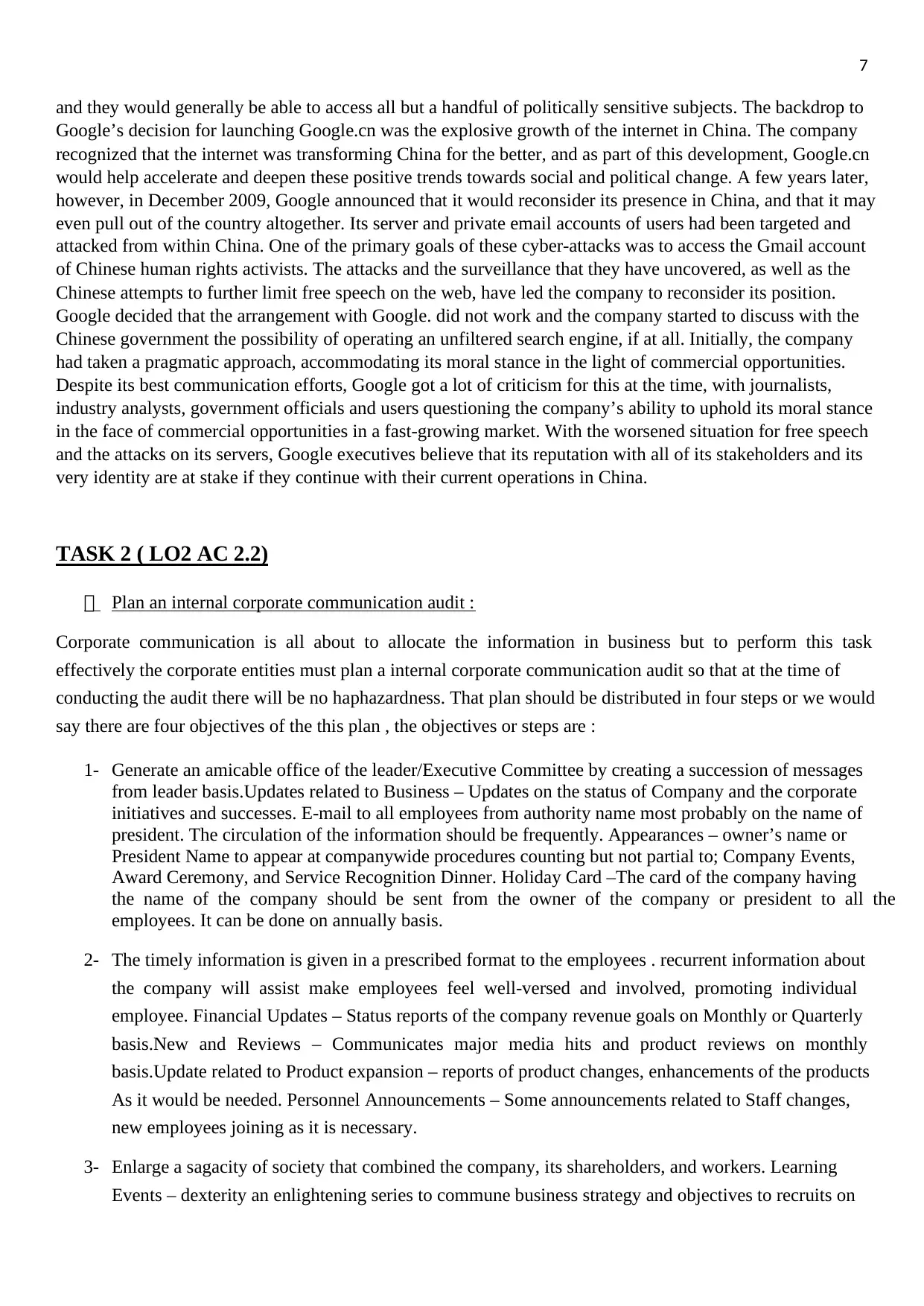
7
and they would generally be able to access all but a handful of politically sensitive subjects. The backdrop to
Google’s decision for launching Google.cn was the explosive growth of the internet in China. The company
recognized that the internet was transforming China for the better, and as part of this development, Google.cn
would help accelerate and deepen these positive trends towards social and political change. A few years later,
however, in December 2009, Google announced that it would reconsider its presence in China, and that it may
even pull out of the country altogether. Its server and private email accounts of users had been targeted and
attacked from within China. One of the primary goals of these cyber-attacks was to access the Gmail account
of Chinese human rights activists. The attacks and the surveillance that they have uncovered, as well as the
Chinese attempts to further limit free speech on the web, have led the company to reconsider its position.
Google decided that the arrangement with Google. did not work and the company started to discuss with the
Chinese government the possibility of operating an unfiltered search engine, if at all. Initially, the company
had taken a pragmatic approach, accommodating its moral stance in the light of commercial opportunities.
Despite its best communication efforts, Google got a lot of criticism for this at the time, with journalists,
industry analysts, government officials and users questioning the company’s ability to uphold its moral stance
in the face of commercial opportunities in a fast-growing market. With the worsened situation for free speech
and the attacks on its servers, Google executives believe that its reputation with all of its stakeholders and its
very identity are at stake if they continue with their current operations in China.
TASK 2 ( LO2 AC 2.2)
Plan an internal corporate communication audit :
Corporate communication is all about to allocate the information in business but to perform this task
effectively the corporate entities must plan a internal corporate communication audit so that at the time of
conducting the audit there will be no haphazardness. That plan should be distributed in four steps or we would
say there are four objectives of the this plan , the objectives or steps are :
1- Generate an amicable office of the leader/Executive Committee by creating a succession of messages
from leader basis.Updates related to Business – Updates on the status of Company and the corporate
initiatives and successes. E-mail to all employees from authority name most probably on the name of
president. The circulation of the information should be frequently. Appearances – owner’s name or
President Name to appear at companywide procedures counting but not partial to; Company Events,
Award Ceremony, and Service Recognition Dinner. Holiday Card –The card of the company having
the name of the company should be sent from the owner of the company or president to all the
employees. It can be done on annually basis.
2- The timely information is given in a prescribed format to the employees . recurrent information about
the company will assist make employees feel well-versed and involved, promoting individual
employee. Financial Updates – Status reports of the company revenue goals on Monthly or Quarterly
basis.New and Reviews – Communicates major media hits and product reviews on monthly
basis.Update related to Product expansion – reports of product changes, enhancements of the products
As it would be needed. Personnel Announcements – Some announcements related to Staff changes,
new employees joining as it is necessary.
3- Enlarge a sagacity of society that combined the company, its shareholders, and workers. Learning
Events – dexterity an enlightening series to commune business strategy and objectives to recruits on
and they would generally be able to access all but a handful of politically sensitive subjects. The backdrop to
Google’s decision for launching Google.cn was the explosive growth of the internet in China. The company
recognized that the internet was transforming China for the better, and as part of this development, Google.cn
would help accelerate and deepen these positive trends towards social and political change. A few years later,
however, in December 2009, Google announced that it would reconsider its presence in China, and that it may
even pull out of the country altogether. Its server and private email accounts of users had been targeted and
attacked from within China. One of the primary goals of these cyber-attacks was to access the Gmail account
of Chinese human rights activists. The attacks and the surveillance that they have uncovered, as well as the
Chinese attempts to further limit free speech on the web, have led the company to reconsider its position.
Google decided that the arrangement with Google. did not work and the company started to discuss with the
Chinese government the possibility of operating an unfiltered search engine, if at all. Initially, the company
had taken a pragmatic approach, accommodating its moral stance in the light of commercial opportunities.
Despite its best communication efforts, Google got a lot of criticism for this at the time, with journalists,
industry analysts, government officials and users questioning the company’s ability to uphold its moral stance
in the face of commercial opportunities in a fast-growing market. With the worsened situation for free speech
and the attacks on its servers, Google executives believe that its reputation with all of its stakeholders and its
very identity are at stake if they continue with their current operations in China.
TASK 2 ( LO2 AC 2.2)
Plan an internal corporate communication audit :
Corporate communication is all about to allocate the information in business but to perform this task
effectively the corporate entities must plan a internal corporate communication audit so that at the time of
conducting the audit there will be no haphazardness. That plan should be distributed in four steps or we would
say there are four objectives of the this plan , the objectives or steps are :
1- Generate an amicable office of the leader/Executive Committee by creating a succession of messages
from leader basis.Updates related to Business – Updates on the status of Company and the corporate
initiatives and successes. E-mail to all employees from authority name most probably on the name of
president. The circulation of the information should be frequently. Appearances – owner’s name or
President Name to appear at companywide procedures counting but not partial to; Company Events,
Award Ceremony, and Service Recognition Dinner. Holiday Card –The card of the company having
the name of the company should be sent from the owner of the company or president to all the
employees. It can be done on annually basis.
2- The timely information is given in a prescribed format to the employees . recurrent information about
the company will assist make employees feel well-versed and involved, promoting individual
employee. Financial Updates – Status reports of the company revenue goals on Monthly or Quarterly
basis.New and Reviews – Communicates major media hits and product reviews on monthly
basis.Update related to Product expansion – reports of product changes, enhancements of the products
As it would be needed. Personnel Announcements – Some announcements related to Staff changes,
new employees joining as it is necessary.
3- Enlarge a sagacity of society that combined the company, its shareholders, and workers. Learning
Events – dexterity an enlightening series to commune business strategy and objectives to recruits on
Paraphrase This Document
Need a fresh take? Get an instant paraphrase of this document with our AI Paraphraser
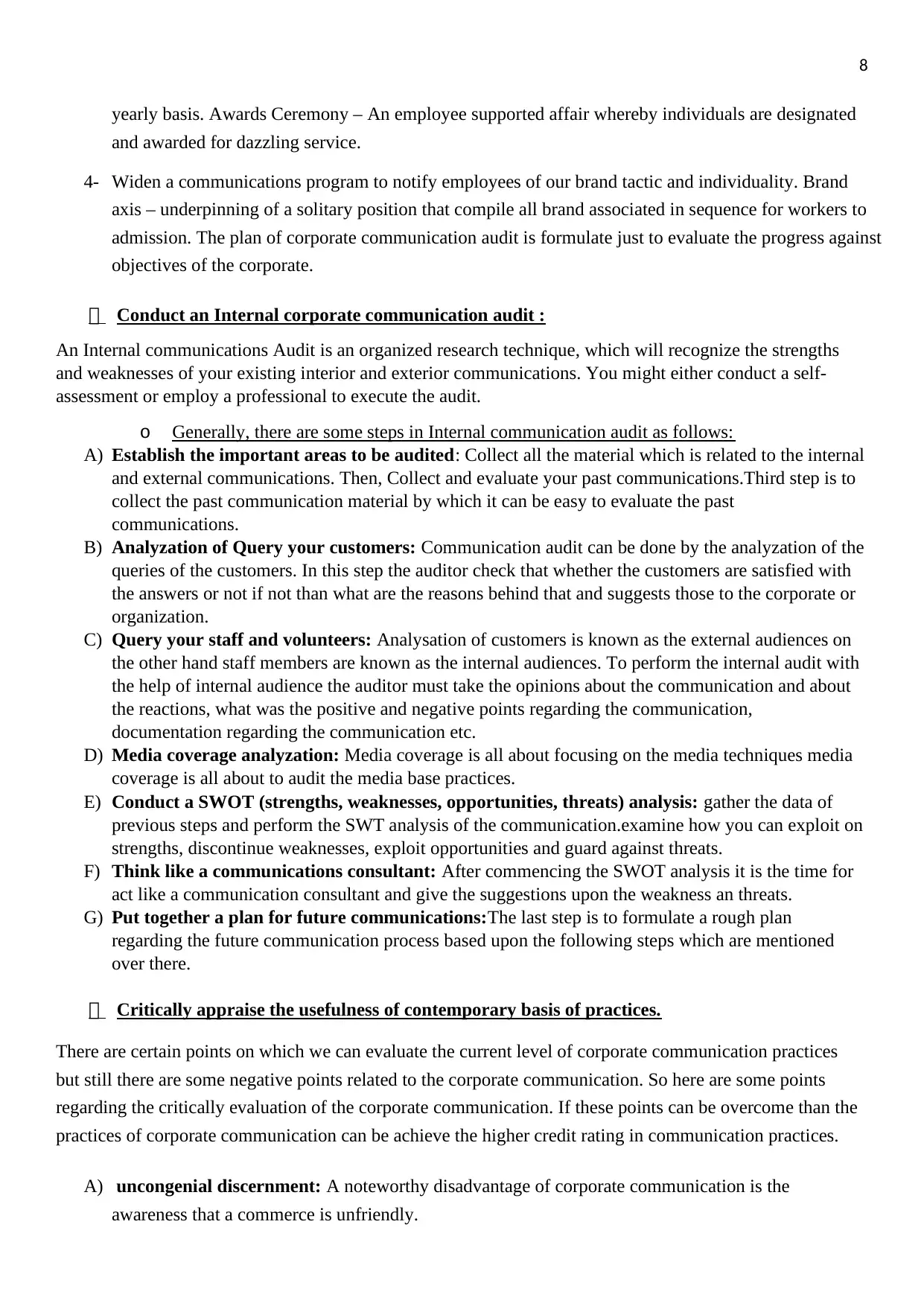
8
yearly basis. Awards Ceremony – An employee supported affair whereby individuals are designated
and awarded for dazzling service.
4- Widen a communications program to notify employees of our brand tactic and individuality. Brand
axis – underpinning of a solitary position that compile all brand associated in sequence for workers to
admission. The plan of corporate communication audit is formulate just to evaluate the progress against
objectives of the corporate.
Conduct an Internal corporate communication audit :
An Internal communications Audit is an organized research technique, which will recognize the strengths
and weaknesses of your existing interior and exterior communications. You might either conduct a self-
assessment or employ a professional to execute the audit.
o Generally, there are some steps in Internal communication audit as follows:
A) Establish the important areas to be audited: Collect all the material which is related to the internal
and external communications. Then, Collect and evaluate your past communications.Third step is to
collect the past communication material by which it can be easy to evaluate the past
communications.
B) Analyzation of Query your customers: Communication audit can be done by the analyzation of the
queries of the customers. In this step the auditor check that whether the customers are satisfied with
the answers or not if not than what are the reasons behind that and suggests those to the corporate or
organization.
C) Query your staff and volunteers: Analysation of customers is known as the external audiences on
the other hand staff members are known as the internal audiences. To perform the internal audit with
the help of internal audience the auditor must take the opinions about the communication and about
the reactions, what was the positive and negative points regarding the communication,
documentation regarding the communication etc.
D) Media coverage analyzation: Media coverage is all about focusing on the media techniques media
coverage is all about to audit the media base practices.
E) Conduct a SWOT (strengths, weaknesses, opportunities, threats) analysis: gather the data of
previous steps and perform the SWT analysis of the communication.examine how you can exploit on
strengths, discontinue weaknesses, exploit opportunities and guard against threats.
F) Think like a communications consultant: After commencing the SWOT analysis it is the time for
act like a communication consultant and give the suggestions upon the weakness an threats.
G) Put together a plan for future communications:The last step is to formulate a rough plan
regarding the future communication process based upon the following steps which are mentioned
over there.
Critically appraise the usefulness of contemporary basis of practices.
There are certain points on which we can evaluate the current level of corporate communication practices
but still there are some negative points related to the corporate communication. So here are some points
regarding the critically evaluation of the corporate communication. If these points can be overcome than the
practices of corporate communication can be achieve the higher credit rating in communication practices.
A) uncongenial discernment: A noteworthy disadvantage of corporate communication is the
awareness that a commerce is unfriendly.
yearly basis. Awards Ceremony – An employee supported affair whereby individuals are designated
and awarded for dazzling service.
4- Widen a communications program to notify employees of our brand tactic and individuality. Brand
axis – underpinning of a solitary position that compile all brand associated in sequence for workers to
admission. The plan of corporate communication audit is formulate just to evaluate the progress against
objectives of the corporate.
Conduct an Internal corporate communication audit :
An Internal communications Audit is an organized research technique, which will recognize the strengths
and weaknesses of your existing interior and exterior communications. You might either conduct a self-
assessment or employ a professional to execute the audit.
o Generally, there are some steps in Internal communication audit as follows:
A) Establish the important areas to be audited: Collect all the material which is related to the internal
and external communications. Then, Collect and evaluate your past communications.Third step is to
collect the past communication material by which it can be easy to evaluate the past
communications.
B) Analyzation of Query your customers: Communication audit can be done by the analyzation of the
queries of the customers. In this step the auditor check that whether the customers are satisfied with
the answers or not if not than what are the reasons behind that and suggests those to the corporate or
organization.
C) Query your staff and volunteers: Analysation of customers is known as the external audiences on
the other hand staff members are known as the internal audiences. To perform the internal audit with
the help of internal audience the auditor must take the opinions about the communication and about
the reactions, what was the positive and negative points regarding the communication,
documentation regarding the communication etc.
D) Media coverage analyzation: Media coverage is all about focusing on the media techniques media
coverage is all about to audit the media base practices.
E) Conduct a SWOT (strengths, weaknesses, opportunities, threats) analysis: gather the data of
previous steps and perform the SWT analysis of the communication.examine how you can exploit on
strengths, discontinue weaknesses, exploit opportunities and guard against threats.
F) Think like a communications consultant: After commencing the SWOT analysis it is the time for
act like a communication consultant and give the suggestions upon the weakness an threats.
G) Put together a plan for future communications:The last step is to formulate a rough plan
regarding the future communication process based upon the following steps which are mentioned
over there.
Critically appraise the usefulness of contemporary basis of practices.
There are certain points on which we can evaluate the current level of corporate communication practices
but still there are some negative points related to the corporate communication. So here are some points
regarding the critically evaluation of the corporate communication. If these points can be overcome than the
practices of corporate communication can be achieve the higher credit rating in communication practices.
A) uncongenial discernment: A noteworthy disadvantage of corporate communication is the
awareness that a commerce is unfriendly.
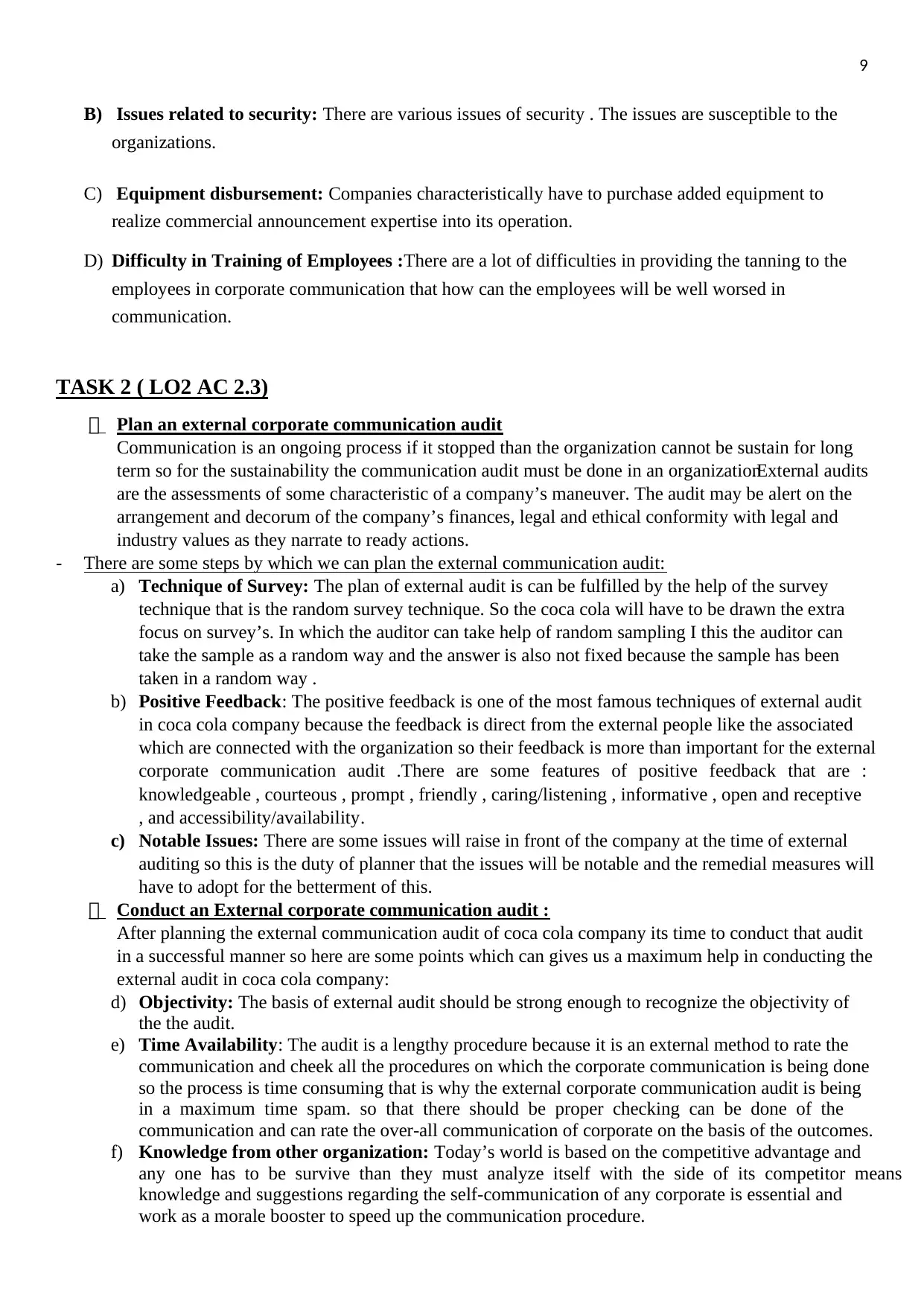
9
B) Issues related to security: There are various issues of security . The issues are susceptible to the
organizations.
C) Equipment disbursement: Companies characteristically have to purchase added equipment to
realize commercial announcement expertise into its operation.
D) Difficulty in Training of Employees :There are a lot of difficulties in providing the tanning to the
employees in corporate communication that how can the employees will be well worsed in
communication.
TASK 2 ( LO2 AC 2.3)
Plan an external corporate communication audit
Communication is an ongoing process if it stopped than the organization cannot be sustain for long
term so for the sustainability the communication audit must be done in an organization.External audits
are the assessments of some characteristic of a company’s maneuver. The audit may be alert on the
arrangement and decorum of the company’s finances, legal and ethical conformity with legal and
industry values as they narrate to ready actions.
- There are some steps by which we can plan the external communication audit:
a) Technique of Survey: The plan of external audit is can be fulfilled by the help of the survey
technique that is the random survey technique. So the coca cola will have to be drawn the extra
focus on survey’s. In which the auditor can take help of random sampling I this the auditor can
take the sample as a random way and the answer is also not fixed because the sample has been
taken in a random way .
b) Positive Feedback: The positive feedback is one of the most famous techniques of external audit
in coca cola company because the feedback is direct from the external people like the associated
which are connected with the organization so their feedback is more than important for the external
corporate communication audit .There are some features of positive feedback that are :
knowledgeable , courteous , prompt , friendly , caring/listening , informative , open and receptive
, and accessibility/availability .
c) Notable Issues: There are some issues will raise in front of the company at the time of external
auditing so this is the duty of planner that the issues will be notable and the remedial measures will
have to adopt for the betterment of this.
Conduct an External corporate communication audit :
After planning the external communication audit of coca cola company its time to conduct that audit
in a successful manner so here are some points which can gives us a maximum help in conducting the
external audit in coca cola company:
d) Objectivity: The basis of external audit should be strong enough to recognize the objectivity of
the the audit.
e) Time Availability: The audit is a lengthy procedure because it is an external method to rate the
communication and cheek all the procedures on which the corporate communication is being done
so the process is time consuming that is why the external corporate communication audit is being
in a maximum time spam. so that there should be proper checking can be done of the
communication and can rate the over-all communication of corporate on the basis of the outcomes.
f) Knowledge from other organization: Today’s world is based on the competitive advantage and
any one has to be survive than they must analyze itself with the side of its competitor means
knowledge and suggestions regarding the self-communication of any corporate is essential and
work as a morale booster to speed up the communication procedure.
B) Issues related to security: There are various issues of security . The issues are susceptible to the
organizations.
C) Equipment disbursement: Companies characteristically have to purchase added equipment to
realize commercial announcement expertise into its operation.
D) Difficulty in Training of Employees :There are a lot of difficulties in providing the tanning to the
employees in corporate communication that how can the employees will be well worsed in
communication.
TASK 2 ( LO2 AC 2.3)
Plan an external corporate communication audit
Communication is an ongoing process if it stopped than the organization cannot be sustain for long
term so for the sustainability the communication audit must be done in an organization.External audits
are the assessments of some characteristic of a company’s maneuver. The audit may be alert on the
arrangement and decorum of the company’s finances, legal and ethical conformity with legal and
industry values as they narrate to ready actions.
- There are some steps by which we can plan the external communication audit:
a) Technique of Survey: The plan of external audit is can be fulfilled by the help of the survey
technique that is the random survey technique. So the coca cola will have to be drawn the extra
focus on survey’s. In which the auditor can take help of random sampling I this the auditor can
take the sample as a random way and the answer is also not fixed because the sample has been
taken in a random way .
b) Positive Feedback: The positive feedback is one of the most famous techniques of external audit
in coca cola company because the feedback is direct from the external people like the associated
which are connected with the organization so their feedback is more than important for the external
corporate communication audit .There are some features of positive feedback that are :
knowledgeable , courteous , prompt , friendly , caring/listening , informative , open and receptive
, and accessibility/availability .
c) Notable Issues: There are some issues will raise in front of the company at the time of external
auditing so this is the duty of planner that the issues will be notable and the remedial measures will
have to adopt for the betterment of this.
Conduct an External corporate communication audit :
After planning the external communication audit of coca cola company its time to conduct that audit
in a successful manner so here are some points which can gives us a maximum help in conducting the
external audit in coca cola company:
d) Objectivity: The basis of external audit should be strong enough to recognize the objectivity of
the the audit.
e) Time Availability: The audit is a lengthy procedure because it is an external method to rate the
communication and cheek all the procedures on which the corporate communication is being done
so the process is time consuming that is why the external corporate communication audit is being
in a maximum time spam. so that there should be proper checking can be done of the
communication and can rate the over-all communication of corporate on the basis of the outcomes.
f) Knowledge from other organization: Today’s world is based on the competitive advantage and
any one has to be survive than they must analyze itself with the side of its competitor means
knowledge and suggestions regarding the self-communication of any corporate is essential and
work as a morale booster to speed up the communication procedure.
⊘ This is a preview!⊘
Do you want full access?
Subscribe today to unlock all pages.

Trusted by 1+ million students worldwide
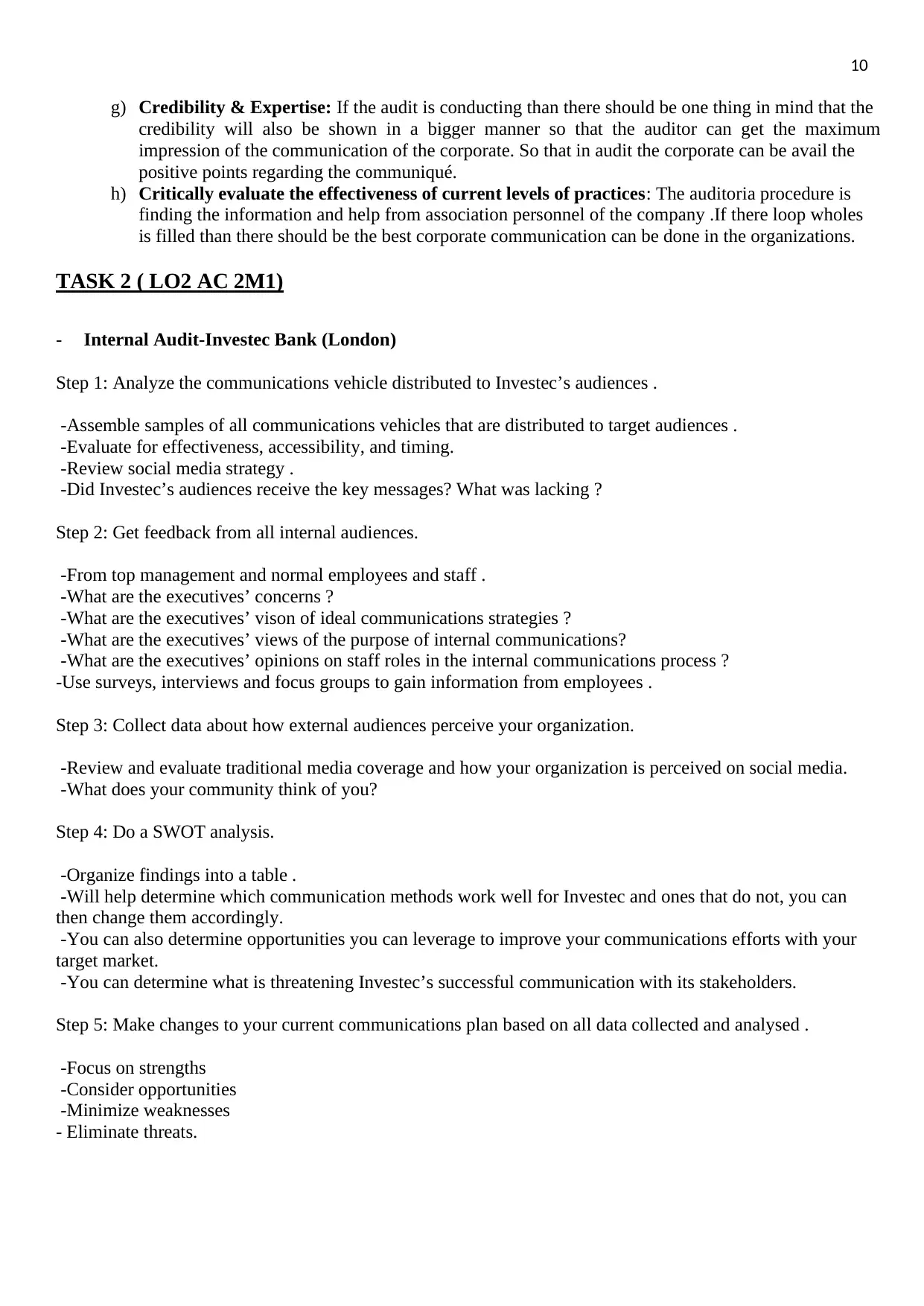
10
g) Credibility & Expertise: If the audit is conducting than there should be one thing in mind that the
credibility will also be shown in a bigger manner so that the auditor can get the maximum
impression of the communication of the corporate. So that in audit the corporate can be avail the
positive points regarding the communiqué.
h) Critically evaluate the effectiveness of current levels of practices: The auditoria procedure is
finding the information and help from association personnel of the company .If there loop wholes
is filled than there should be the best corporate communication can be done in the organizations.
TASK 2 ( LO2 AC 2M1)
- Internal Audit-Investec Bank (London)
Step 1: Analyze the communications vehicle distributed to Investec’s audiences .
-Assemble samples of all communications vehicles that are distributed to target audiences .
-Evaluate for effectiveness, accessibility, and timing.
-Review social media strategy .
-Did Investec’s audiences receive the key messages? What was lacking ?
Step 2: Get feedback from all internal audiences.
-From top management and normal employees and staff .
-What are the executives’ concerns ?
-What are the executives’ vison of ideal communications strategies ?
-What are the executives’ views of the purpose of internal communications?
-What are the executives’ opinions on staff roles in the internal communications process ?
-Use surveys, interviews and focus groups to gain information from employees .
Step 3: Collect data about how external audiences perceive your organization.
-Review and evaluate traditional media coverage and how your organization is perceived on social media.
-What does your community think of you?
Step 4: Do a SWOT analysis.
-Organize findings into a table .
-Will help determine which communication methods work well for Investec and ones that do not, you can
then change them accordingly.
-You can also determine opportunities you can leverage to improve your communications efforts with your
target market.
-You can determine what is threatening Investec’s successful communication with its stakeholders.
Step 5: Make changes to your current communications plan based on all data collected and analysed .
-Focus on strengths
-Consider opportunities
-Minimize weaknesses
- Eliminate threats.
g) Credibility & Expertise: If the audit is conducting than there should be one thing in mind that the
credibility will also be shown in a bigger manner so that the auditor can get the maximum
impression of the communication of the corporate. So that in audit the corporate can be avail the
positive points regarding the communiqué.
h) Critically evaluate the effectiveness of current levels of practices: The auditoria procedure is
finding the information and help from association personnel of the company .If there loop wholes
is filled than there should be the best corporate communication can be done in the organizations.
TASK 2 ( LO2 AC 2M1)
- Internal Audit-Investec Bank (London)
Step 1: Analyze the communications vehicle distributed to Investec’s audiences .
-Assemble samples of all communications vehicles that are distributed to target audiences .
-Evaluate for effectiveness, accessibility, and timing.
-Review social media strategy .
-Did Investec’s audiences receive the key messages? What was lacking ?
Step 2: Get feedback from all internal audiences.
-From top management and normal employees and staff .
-What are the executives’ concerns ?
-What are the executives’ vison of ideal communications strategies ?
-What are the executives’ views of the purpose of internal communications?
-What are the executives’ opinions on staff roles in the internal communications process ?
-Use surveys, interviews and focus groups to gain information from employees .
Step 3: Collect data about how external audiences perceive your organization.
-Review and evaluate traditional media coverage and how your organization is perceived on social media.
-What does your community think of you?
Step 4: Do a SWOT analysis.
-Organize findings into a table .
-Will help determine which communication methods work well for Investec and ones that do not, you can
then change them accordingly.
-You can also determine opportunities you can leverage to improve your communications efforts with your
target market.
-You can determine what is threatening Investec’s successful communication with its stakeholders.
Step 5: Make changes to your current communications plan based on all data collected and analysed .
-Focus on strengths
-Consider opportunities
-Minimize weaknesses
- Eliminate threats.
Paraphrase This Document
Need a fresh take? Get an instant paraphrase of this document with our AI Paraphraser
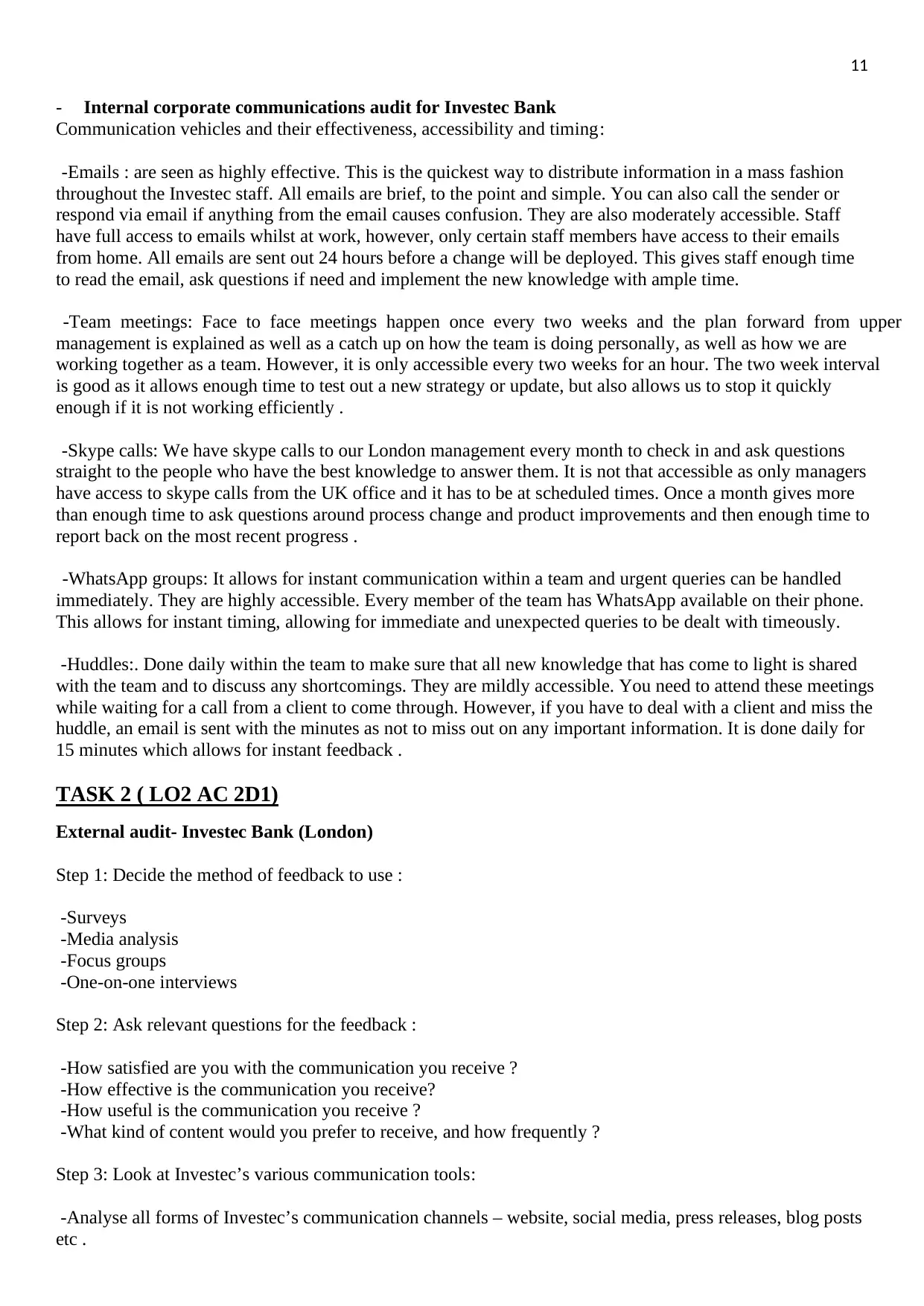
11
- Internal corporate communications audit for Investec Bank
Communication vehicles and their effectiveness, accessibility and timing :
-Emails : are seen as highly effective. This is the quickest way to distribute information in a mass fashion
throughout the Investec staff. All emails are brief, to the point and simple. You can also call the sender or
respond via email if anything from the email causes confusion. They are also moderately accessible. Staff
have full access to emails whilst at work, however, only certain staff members have access to their emails
from home. All emails are sent out 24 hours before a change will be deployed. This gives staff enough time
to read the email, ask questions if need and implement the new knowledge with ample time.
-Team meetings: Face to face meetings happen once every two weeks and the plan forward from upper
management is explained as well as a catch up on how the team is doing personally, as well as how we are
working together as a team. However, it is only accessible every two weeks for an hour. The two week interval
is good as it allows enough time to test out a new strategy or update, but also allows us to stop it quickly
enough if it is not working efficiently .
-Skype calls: We have skype calls to our London management every month to check in and ask questions
straight to the people who have the best knowledge to answer them. It is not that accessible as only managers
have access to skype calls from the UK office and it has to be at scheduled times. Once a month gives more
than enough time to ask questions around process change and product improvements and then enough time to
report back on the most recent progress .
-WhatsApp groups: It allows for instant communication within a team and urgent queries can be handled
immediately. They are highly accessible. Every member of the team has WhatsApp available on their phone.
This allows for instant timing, allowing for immediate and unexpected queries to be dealt with timeously.
-Huddles:. Done daily within the team to make sure that all new knowledge that has come to light is shared
with the team and to discuss any shortcomings. They are mildly accessible. You need to attend these meetings
while waiting for a call from a client to come through. However, if you have to deal with a client and miss the
huddle, an email is sent with the minutes as not to miss out on any important information. It is done daily for
15 minutes which allows for instant feedback .
TASK 2 ( LO2 AC 2D1)
External audit- Investec Bank (London)
Step 1: Decide the method of feedback to use :
-Surveys
-Media analysis
-Focus groups
-One-on-one interviews
Step 2: Ask relevant questions for the feedback :
-How satisfied are you with the communication you receive ?
-How effective is the communication you receive?
-How useful is the communication you receive ?
-What kind of content would you prefer to receive, and how frequently ?
Step 3: Look at Investec’s various communication tools :
-Analyse all forms of Investec’s communication channels – website, social media, press releases, blog posts
etc .
- Internal corporate communications audit for Investec Bank
Communication vehicles and their effectiveness, accessibility and timing :
-Emails : are seen as highly effective. This is the quickest way to distribute information in a mass fashion
throughout the Investec staff. All emails are brief, to the point and simple. You can also call the sender or
respond via email if anything from the email causes confusion. They are also moderately accessible. Staff
have full access to emails whilst at work, however, only certain staff members have access to their emails
from home. All emails are sent out 24 hours before a change will be deployed. This gives staff enough time
to read the email, ask questions if need and implement the new knowledge with ample time.
-Team meetings: Face to face meetings happen once every two weeks and the plan forward from upper
management is explained as well as a catch up on how the team is doing personally, as well as how we are
working together as a team. However, it is only accessible every two weeks for an hour. The two week interval
is good as it allows enough time to test out a new strategy or update, but also allows us to stop it quickly
enough if it is not working efficiently .
-Skype calls: We have skype calls to our London management every month to check in and ask questions
straight to the people who have the best knowledge to answer them. It is not that accessible as only managers
have access to skype calls from the UK office and it has to be at scheduled times. Once a month gives more
than enough time to ask questions around process change and product improvements and then enough time to
report back on the most recent progress .
-WhatsApp groups: It allows for instant communication within a team and urgent queries can be handled
immediately. They are highly accessible. Every member of the team has WhatsApp available on their phone.
This allows for instant timing, allowing for immediate and unexpected queries to be dealt with timeously.
-Huddles:. Done daily within the team to make sure that all new knowledge that has come to light is shared
with the team and to discuss any shortcomings. They are mildly accessible. You need to attend these meetings
while waiting for a call from a client to come through. However, if you have to deal with a client and miss the
huddle, an email is sent with the minutes as not to miss out on any important information. It is done daily for
15 minutes which allows for instant feedback .
TASK 2 ( LO2 AC 2D1)
External audit- Investec Bank (London)
Step 1: Decide the method of feedback to use :
-Surveys
-Media analysis
-Focus groups
-One-on-one interviews
Step 2: Ask relevant questions for the feedback :
-How satisfied are you with the communication you receive ?
-How effective is the communication you receive?
-How useful is the communication you receive ?
-What kind of content would you prefer to receive, and how frequently ?
Step 3: Look at Investec’s various communication tools :
-Analyse all forms of Investec’s communication channels – website, social media, press releases, blog posts
etc .
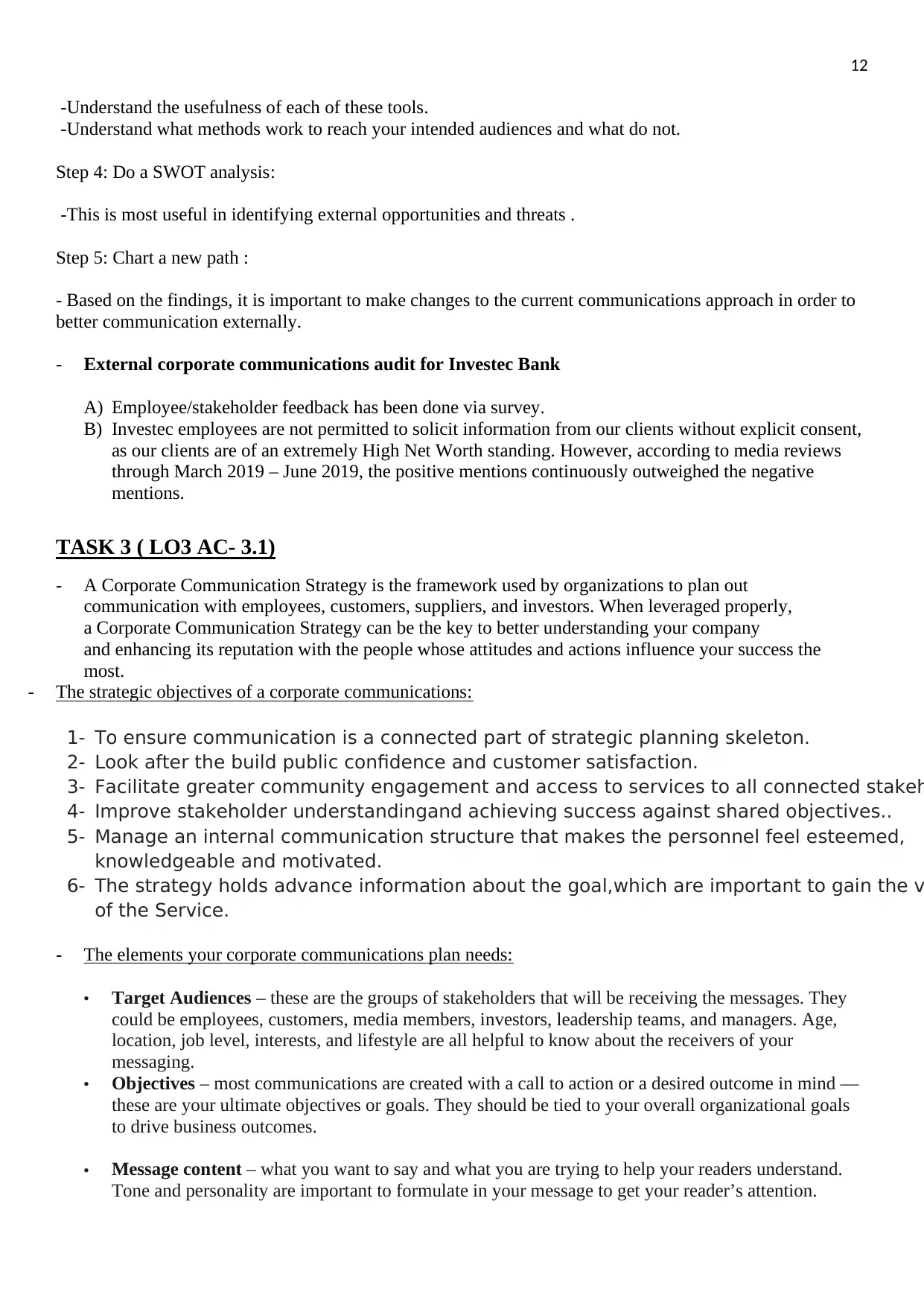
12
-Understand the usefulness of each of these tools.
-Understand what methods work to reach your intended audiences and what do not.
Step 4: Do a SWOT analysis:
-This is most useful in identifying external opportunities and threats .
Step 5: Chart a new path :
- Based on the findings, it is important to make changes to the current communications approach in order to
better communication externally.
- External corporate communications audit for Investec Bank
A) Employee/stakeholder feedback has been done via survey.
B) Investec employees are not permitted to solicit information from our clients without explicit consent,
as our clients are of an extremely High Net Worth standing. However, according to media reviews
through March 2019 – June 2019, the positive mentions continuously outweighed the negative
mentions.
TASK 3 ( LO3 AC- 3.1)
- A Corporate Communication Strategy is the framework used by organizations to plan out
communication with employees, customers, suppliers, and investors. When leveraged properly,
a Corporate Communication Strategy can be the key to better understanding your company
and enhancing its reputation with the people whose attitudes and actions influence your success the
most.
- The strategic objectives of a corporate communications:
1- To ensure communication is a connected part of strategic planning skeleton.
2- Look after the build public confidence and customer satisfaction.
3- Facilitate greater community engagement and access to services to all connected stakeh
4- Improve stakeholder understandingand achieving success against shared objectives..
5- Manage an internal communication structure that makes the personnel feel esteemed,
knowledgeable and motivated.
6- The strategy holds advance information about the goal,which are important to gain the v
of the Service.
- The elements your corporate communications plan needs:
• Target Audiences – these are the groups of stakeholders that will be receiving the messages. They
could be employees, customers, media members, investors, leadership teams, and managers. Age,
location, job level, interests, and lifestyle are all helpful to know about the receivers of your
messaging.
• Objectives – most communications are created with a call to action or a desired outcome in mind —
these are your ultimate objectives or goals. They should be tied to your overall organizational goals
to drive business outcomes.
• Message content – what you want to say and what you are trying to help your readers understand.
Tone and personality are important to formulate in your message to get your reader’s attention.
-Understand the usefulness of each of these tools.
-Understand what methods work to reach your intended audiences and what do not.
Step 4: Do a SWOT analysis:
-This is most useful in identifying external opportunities and threats .
Step 5: Chart a new path :
- Based on the findings, it is important to make changes to the current communications approach in order to
better communication externally.
- External corporate communications audit for Investec Bank
A) Employee/stakeholder feedback has been done via survey.
B) Investec employees are not permitted to solicit information from our clients without explicit consent,
as our clients are of an extremely High Net Worth standing. However, according to media reviews
through March 2019 – June 2019, the positive mentions continuously outweighed the negative
mentions.
TASK 3 ( LO3 AC- 3.1)
- A Corporate Communication Strategy is the framework used by organizations to plan out
communication with employees, customers, suppliers, and investors. When leveraged properly,
a Corporate Communication Strategy can be the key to better understanding your company
and enhancing its reputation with the people whose attitudes and actions influence your success the
most.
- The strategic objectives of a corporate communications:
1- To ensure communication is a connected part of strategic planning skeleton.
2- Look after the build public confidence and customer satisfaction.
3- Facilitate greater community engagement and access to services to all connected stakeh
4- Improve stakeholder understandingand achieving success against shared objectives..
5- Manage an internal communication structure that makes the personnel feel esteemed,
knowledgeable and motivated.
6- The strategy holds advance information about the goal,which are important to gain the v
of the Service.
- The elements your corporate communications plan needs:
• Target Audiences – these are the groups of stakeholders that will be receiving the messages. They
could be employees, customers, media members, investors, leadership teams, and managers. Age,
location, job level, interests, and lifestyle are all helpful to know about the receivers of your
messaging.
• Objectives – most communications are created with a call to action or a desired outcome in mind —
these are your ultimate objectives or goals. They should be tied to your overall organizational goals
to drive business outcomes.
• Message content – what you want to say and what you are trying to help your readers understand.
Tone and personality are important to formulate in your message to get your reader’s attention.
⊘ This is a preview!⊘
Do you want full access?
Subscribe today to unlock all pages.

Trusted by 1+ million students worldwide
1 out of 17
Related Documents
Your All-in-One AI-Powered Toolkit for Academic Success.
+13062052269
info@desklib.com
Available 24*7 on WhatsApp / Email
![[object Object]](/_next/static/media/star-bottom.7253800d.svg)
Unlock your academic potential
Copyright © 2020–2025 A2Z Services. All Rights Reserved. Developed and managed by ZUCOL.





